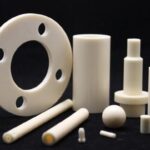Plastic covers a range of synthetic or semisynthetic polymerization products. They are composed of organic condensation or addition polymers and may contain other substances to improve performance or economics. There are few natural polymers generally considered to be “plastics”. Plastics can be formed into objects or films or fibers. Their name is derived from the fact that many are malleable, having the property of plasticity. Plastic can be classified in many ways but most commonly by their polymer backbone (polyvinyl chloride, polyethylene, acrylic, silicone, urethane, etc.). Other classifications include thermoplastic vs. thermoset, elastomer, engineering plastic, addition or condensation, and Glass transition temperature or Tg.
A lot of plastics are partially crystalline and partially amorphous in molecular structure, giving
them both a melting point (the temperature at which the attractive intermolecular forces are overcome) and one or more glass transitions (temperatures at which the degree of cross-linking is substantially reduced).
Plastics are polymers: long chains of atoms bonded to one another. These chains are made up of many repeating molecular units, or “monomers”. The vast majority of plastics are composed of polymers of carbon alone or with oxygen, nitrogen, chlorine or sulfur in the backbone. (Some of commercial interest are silicon based.) The backbone is that part of the chain on the main “path” linking the multitude of monomer units together. To customize the properties of a plastic, different molecular groups “hang” from the backbone (usually they are “hung” as part of the monomers before linking monomers together to form the polymer chain).
Polymerization
The synthesis of the large molecular weight polymers is termed polymerization; it is simply the process by which monomer units are joined over, to generate each of the constituent giant molecules. The reactions by which polymerization occurs are grouped into two general classification- addition and condensation, according to the reaction mechanisms.
Addition polymerization is a process by which bifuncational monomer units are attached one at a time in chainlike fashion to form a linear macromolecules; the composition of the resultant products molecule is an exact multiple for that of the original reactant monomer. Three distinct stages- initiation, propagation and termination are involved in addition polymerization. Condensation polymerization is the formation of polymers by stepwise intermolecular chemical reactions that normally involve more than one monomer species; there is usually a small molecular weight by producer such as water, which is eliminated. No reactant species has the chemical formula of the mer repeat unit, and the intermolecular reaction occurs every time a mer repeat unit is formed


